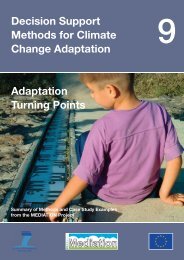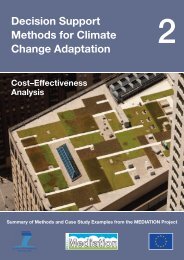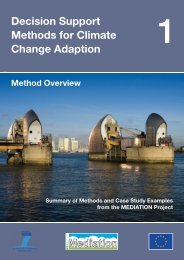Download all Technical Policy Briefing Notes in a single ... - Mediation
Download all Technical Policy Briefing Notes in a single ... - Mediation
Download all Technical Policy Briefing Notes in a single ... - Mediation
- No tags were found...
Create successful ePaper yourself
Turn your PDF publications into a flip-book with our unique Google optimized e-Paper software.
Cost-Effectiveness AnalysisIntroductionThere is <strong>in</strong>creas<strong>in</strong>g policy <strong>in</strong>terest <strong>in</strong> the appraisalof options, as adaptation moves from theory topractice. At the same time, it is recognised thatthe appraisal of climate change adaptation<strong>in</strong>volves a number of major ch<strong>all</strong>enges,particularly the consideration of uncerta<strong>in</strong>ty. Inresponse, a number of exist<strong>in</strong>g and new decisionsupport tools are be<strong>in</strong>g considered for adaptation.The European Commission FP7 fundedMEDIATION project (Methodology for EffectiveDecision-mak<strong>in</strong>g on Impacts and AdaptaTION) islook<strong>in</strong>g at adaptation decision support tools, <strong>in</strong>l<strong>in</strong>e with its objectives to advance the analysis ofimpacts, vulnerability and adaptation, and topromote knowledge shar<strong>in</strong>g through aMEDIATION Adaptation Platform (http://www.mediation-project.eu/platform/). To complementthe <strong>in</strong>formation on the Platform, a series of <strong>Policy</strong><strong>Brief<strong>in</strong>g</strong> <strong>Notes</strong> have been produced on DecisionSupport Methods for Climate Change Adaptation.An overview of <strong>all</strong> the decision support toolsreviewed is provided <strong>in</strong> <strong>Policy</strong> <strong>Brief<strong>in</strong>g</strong> Note 1:Method Overview, which summarises eachmethod, discusses the potential relevance foradaptation and provides guidance on theirpotential applicability. The methods considered<strong>in</strong>clude exist<strong>in</strong>g appraisal tools (cost-benefitanalysis, cost-effectiveness analysis and multicriteriaanalysis), as well as techniques that morefully address uncerta<strong>in</strong>ty (real options analysis,robust decision mak<strong>in</strong>g, portfolio analysis anditerative risk (adaptive) management). It also<strong>in</strong>cludes complementary tools that can assist <strong>in</strong>adaptation assessment, <strong>in</strong>clud<strong>in</strong>g analyticalhierarchic processes, social network analysisand adaptation turn<strong>in</strong>g po<strong>in</strong>ts. Additional<strong>in</strong>formation on each method is presented <strong>in</strong> aseparate <strong>Policy</strong> <strong>Brief<strong>in</strong>g</strong> <strong>Notes</strong> (2 – 10).This <strong>Policy</strong> Brief (Note 2) provides a summary ofcost-effectiveness analysis. It provides a briefsynthesis of the approach, its strengths andweaknesses, the relevance for adaptation, how itconsiders uncerta<strong>in</strong>ty, and presents case studyexamples. It is stressed that this note onlyprovides an overview: more detailed <strong>in</strong>formation isavailable <strong>in</strong> MEDIATION deliverables, and sourcesand l<strong>in</strong>ks on the MEDIATION Adaptation Platform.Description of the MethodCost-Effectiveness Analysis (CEA) is a widelyused decision support tool. It comparesalternative options for achiev<strong>in</strong>g similar outputs(or objectives). In this regard it is a relativemeasure, provid<strong>in</strong>g comparative <strong>in</strong>formationbetween choices. It has been widely used <strong>in</strong>environmental policy analysis, because it avoidsmonetary valuation of benefits, and <strong>in</strong>steadquantifies benefits <strong>in</strong> physical terms.At the technical or project level, CEA can beused to compare and rank alternative options. Itdoes this by assess<strong>in</strong>g options <strong>in</strong> terms of thecost per unit of benefit delivered, e.g. cost pertonne of pollution abated. This identifies thoseoptions that deliver highest benefit for lowestcost (i.e. the most cost-effective). As well asrank<strong>in</strong>g different options, such an analysis canbe used for benchmark<strong>in</strong>g, see box.At the project, policy or programme level, wherecomb<strong>in</strong>ations of options are needed, CEA can beused to assess the most cost-effective order ofoptions, and so identify the least-cost path forachiev<strong>in</strong>g pre-def<strong>in</strong>ed policy targets. This isBox 1. Benchmark<strong>in</strong>g us<strong>in</strong>g CEACost-effectiveness analysis can be used to benchmark options, i.e. by sett<strong>in</strong>g thresholds. Thisapproach is often used <strong>in</strong> consider<strong>in</strong>g new treatments <strong>in</strong> health service provision (e.g. <strong>in</strong> the UK),where the cl<strong>in</strong>ic effectiveness of new <strong>in</strong>terventions are compared aga<strong>in</strong>st a cost-effectivenessthreshold, measured as the cost (£) per Quality Adjusted Life Year (QALY). New treatments or drugsare considered cost-effective if they are lower than £20 000 to £30 000 per QALY (NICE, 2010). Suchan approach is needed because publicly funded healthcare systems cannot pay for every newmedical treatment that becomes available. As there are limited resources, choices have to be made,cost-effectiveness analysis helps provide the largest benefits with the available resources.1





